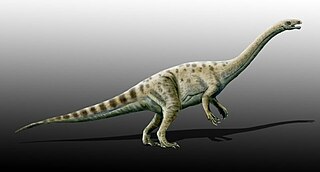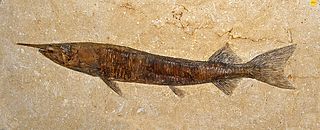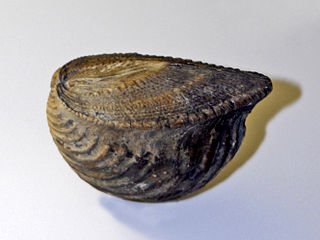Related Research Articles

Cycads are seed plants that typically have a stout and woody (ligneous) trunk with a crown of large, hard, stiff, evergreen and (usually) pinnate leaves. The species are dioecious, that is, individual plants of a species are either male or female. Cycads vary in size from having trunks only a few centimeters to several meters tall. They typically grow slowly and have long lifespans. Because of their superficial resemblance to palms or ferns, they are sometimes mistaken for them, but they are not closely related to either group. Cycads are gymnosperms (naked-seeded), meaning their unfertilized seeds are open to the air to be directly fertilized by pollination, as contrasted with angiosperms, which have enclosed seeds with more complex fertilization arrangements. Cycads have very specialized pollinators, usually a specific species of beetle. Both male and female cycads bear cones (strobili), somewhat similar to conifer cones.

Cryolophosaurus is a genus of large theropod dinosaur known from only a single species Cryolophosaurus ellioti, from the early Jurassic of Antarctica. It was one of the largest theropods of the Early Jurassic, with the subadult being estimated to have reached 6–7 metres (20–23 ft) long and weighed 350–465 kilograms (772–1,025 lb).

Claytosmunda is a genus of fern. It has only one extant species, Claytosmunda claytoniana, the interrupted fern, native to Eastern Asia, Eastern United States, and Eastern Canada.

Aspidorhynchus is an extinct genus of predatory ray-finned fish from the Middle Jurassic to the earliest Cretaceous. Fossils have been found in Europe, Antarctica and the Caribbean.

Dracovenator is a genus of neotheropod dinosaur that lived approximately 201 to 199 million years ago during the early part of the Jurassic Period in what is now South Africa. Dracovenator was a medium-sized, moderately-built, ground-dwelling, bipedal carnivore, that could grow up to an estimated 5.5–6.5 metres (18–21 ft) in length and 250 kilograms (550 lb) in body mass. Its type specimen was based on only a partial skull that was recovered.

The Hanson Formation is a geologic formation on Mount Kirkpatrick and north Victoria Land, Antarctica. It is one of the two major dinosaur-bearing rock groups found on Antarctica to date; the other is the Snow Hill Island Formation and related formations from the Late Cretaceous of the Antarctic Peninsula. The formation has yielded some Mesozoic specimens, but most of it is as yet unexcavated. Part of the Victoria Group of the Transantarctic Mountains, it lies below the Prebble Formation and above the Falla Formation. The formation includes material from volcanic activity linked to the Karoo-Ferar eruptions of the Lower Jurassic. The climate of the zone was similar to that of modern southern Chile, humid, with a temperature interval of 17–18 degrees. The Hanson Formation is correlated with the Section Peak Formation of the Eisenhower Range and Deep Freeze Range, as well as volcanic deposits on the Convoy Range and Ricker Hills of southern Victoria Land. Recent work has successfully correlated the Upper Section Peak Formation, as well unnamed deposits in Convoy Range and Ricker Hills with the Lower Hanson, all likely of Sinemurian age and connected by layers of silicic ash, while the upper section has been found to be Pliensbachian, and correlated with a greater volcanic pulse, marked by massive ash inputs.

Trachyteuthis is a genus of extinct octopodiform cephalopods, comprising six species: T. hastiformis, T. latipinnis, T. nusplingensis, T. teudopsiformis, T. covacevichi and T. chilensis.

Massospondylidae is a family of early massopod dinosaurs that existed in Asia, Africa, North America, South America and Antarctica during the Late Triassic to the Early Jurassic periods. Several dinosaurs have been classified as massospondylids over the years. The largest cladistic analysis of early sauropodomorphs, which was presented by Apaldetti and colleagues in November 2011, found Adeopapposaurus, Coloradisaurus, Glacialisaurus, Massospondylus, Leyesaurus and Lufengosaurus to be massospondylids. This result supports many previous analyses that tested fewer taxa. However, this analysis found the two recently described North American massopods, Sarahsaurus and Seitaad, and the South African Ignavusaurus to nest outside Massospondylidae, as opposed to some provisional proposals. Earlier in 2011, Pradhania, a sauropodomorph from India, was tested for the first time in a large cladistic analysis and was found to be a relatively basal massospondylid. Mussaurus and Xixiposaurus may also be included within Massospondylidae.

Glacialisaurus is a genus of sauropodomorph dinosaur from the Early Jurassic period of Antarctica. It is known from two specimens; the holotype, a partial tarsus (ankle) and metatarsus, and a partial left femur. The fossils were collected by a team led by paleontologist William R. Hammer during a 1990–91 field expedition to the central region of the Transantarctic Mountains. They come from sedimentary rocks of the Hanson Formation and date to the Pliensbachian stage of the Early Jurassic, around 186 to 182 million years ago. The fossils were described in 2007, and made the basis of the new genus and species Glacialisaurus hammeri. The genus name translates as “icy” or "frozen lizard”, and the specific name honors Hammer.

Hibolithes is a genus of belemnite that lived from the Middle Jurassic to the Early Cretaceous, and has been found in Antarctica, Greenland, Iran, Europe, South America, and New Zealand. In 2020, this genus was found in the Pedawan Formation in Sarawak, on the island of Borneo (Malaysia).

Vinctifer is an extinct genus of prehistoric bony fish erected by David Starr Jordan in 1919.

Zamites is a genus of sterile foliage known from the Mesozoic of North America, Europe, India and Antarctica through the Eocene of North America. It was erected as a form taxon for leaves that superficially resembled the extant cycad Zamia, however it is now believed to belong to a similar but phylogenetically different group, the cyacadeoids (Bennettitales). The fronds are linear or lanceolate in shape, and pinnately compound, with pinnae with parallel veins and smooth margins, and symmetrical and constricted at the base where they are attached obliquely to the upper surface of the rachis. It has been interpreted as a Bennettitalean plant in the family Williamsoniaceae. It is associated with the ovulate cone Williamsonia and male cone Weltrichia.

Trigonia is an extinct genus of saltwater clams, fossil marine bivalve mollusk in the family Trigoniidae. The fossil range of the genus spans the Paleozoic, Mesozoic and Paleocene of the Cenozoic, from 298 to 56 Ma.

Pterotrigonia is an extinct genus of saltwater clams, marine bivalve molluscs in the family Megatrigoniidae. This genus is known in the fossil record from the Jurassic period Tithonian age to the Cretaceous period Maastrichtian age. Species in this genus were facultatively mobile infaunal suspension feeders. The type species of the genus is Pterotrigonia cristata.

Archaeomaenidae is an extinct family of stem-teleost fish found in freshwater environments of Jurassic New South Wales of Australia, China, and Antarctica, and in Lower Cretaceous New South Wales and Mongolia.
Caraphlebia is an extinct genus of dragonflies, known from the Early Jurassic Mawson Formation of Antarctica. It is one of the only named fossil insects from Antarctica that have been formally described; others include two beetles, Grahamelytron crofti and Ademosynoides antarctica, both from a Jurassic deposit on Mount Flora Formation. Caraphlebia is related to the genus Liassophlebia, but the hind wing has several weak antipodals in addition to the two strong, primary ones. In 2018, Caraphlebia was confirmed to be placed in the family Selenothemistidae.

The Mawson Formation is a geological formation in Antarctica, dating to roughly between 182 and 177 million years ago and covering the Toarcian stages of the Jurassic Period in the Mesozoic Era. Vertebrate remains are known from the formation. The Mawson Formation is the South Victoria Land equivalent of the Karoo Large Igneous Province in South Africa, as well the Lonco Trapial Formation and the Cañadón Asfalto Formation of Argentina. The Volcanic material was likely sourced from the Antarctic Peninsula´s Ellsworth Land Volcanic Group.
Notidanodon is an extinct genus of cow shark. Fossils ascribed to this genus are known from the Jurassic and Cretaceous periods. Recently, the genus underwent a major revision and was split into two after the erection of Xampylodon to accommodate the species X. dentatus, X. loozi, and X. brotzeni. The genus is now known only from New Zealand, Antarctica, Africa, and South America.

Coniopteris is an extinct genus of Mesozoic fern leaves. It was widespread over both hemispheres during the Jurassic and Early Cretaceous, with over 130 species having been described. While traditionally assumed to have been a member of Dicksoniaceae or a close relative of Thyrsopteris, a 2020 cladistic analysis found it to be a stem group of Polypodiales. Most species of Coniopteris probably had a herbaceous habit. Coniopteris laciniata had tufts of leaves sprouting from intervals of a thin, creeping rhizome. The genus is technically a junior synonym of the little used Polystichites, but was conserved by the ICZN in 2013. Some authors suggest a range of Early Jurassic-early Late Cretaceous for the genus, while others suggest a more expansive range spanning from the Middle Triassic to the Eocene.
References
- ↑
- A. B. Smith and T.H. Tranter. 1985. Protremaster, a new lower jurassic genus of asteroid from Antarctica. Geological Magazine 122(4):351-359